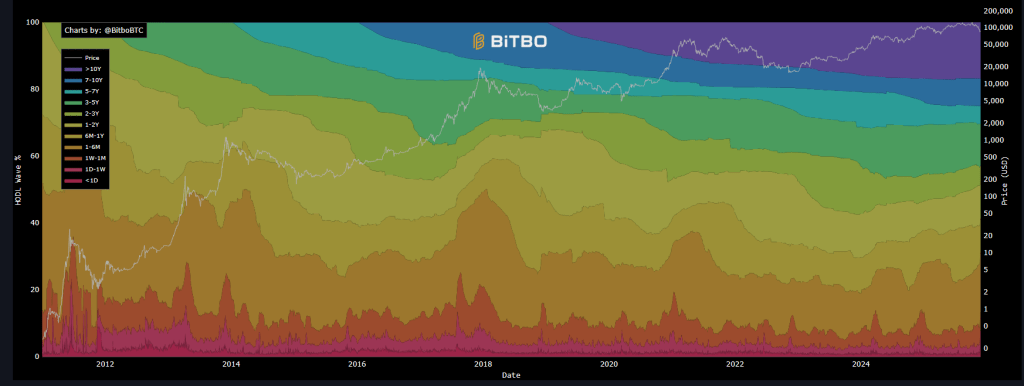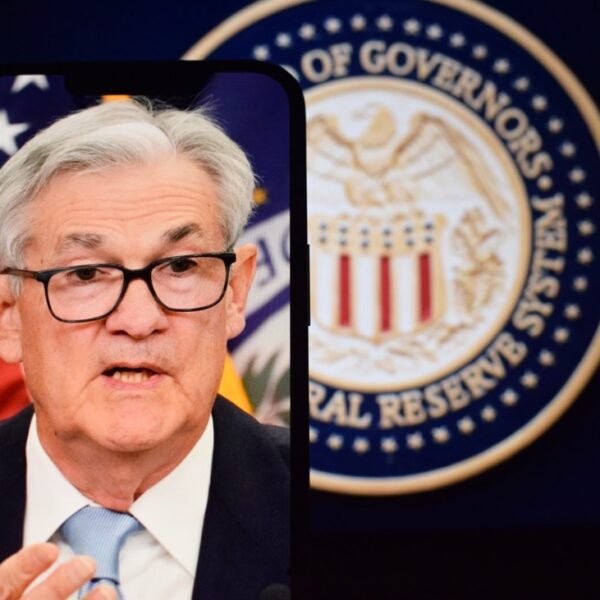
According to on-chain analyst James Check, Bitcoin may face a political crisis as much as a technical one if powerful quantum computers arrive.
He warns that the hard part will not be the math but getting the Bitcoin community to agree on how to protect coins that have not moved for years.
Dormant Supply At Risk
Reports have disclosed that roughly 32.4% of all Bitcoin has not moved in the past five years, and nearly 17% has stayed still for more than a decade.
That stockpile includes addresses that expose public keys, which are the main target if quantum attacks become practical.
Some analysts estimate roughly 6–7 million BTC sit in these vulnerable formats. Those holdings are already being watched by security experts.

HODL Waves chart for Bitcoin, based on BitBo data.
Bitcoin Uses Elliptic Curve Signatures
Bitcoin’s current protection relies on ECDSA and Schnorr signatures. According to researchers and standards bodies, those schemes can be broken by Shor’s algorithm if a large enough quantum computer appears.
The US National Institute of Standards and Technology has approved several quantum-resistant signature schemes, and Bitcoin Improvement Proposal 360 references post-quantum options. Adoption, however, requires wide agreement across the network.
You allow the old coins to come back to market.
Since there is no chance we come to consensus to freeze them, focus on the tech side of quantum safe wallets, and let the market sort out the rest. https://t.co/7xOZRVYl5r
— _Checkmate 🟠🔑⚡☢️🛢️ (@_Checkmatey_) November 23, 2025
Technical Timelines And Estimates
Today’s quantum devices have about 1,000 physical qubits. Some researchers now say a specialized machine with roughly 126,000 physical qubits could break elliptic curve signatures.
Others put the bar at around 2,300 logical qubits. These gaps matter because physical and logical qubits are not the same; heavy error correction is required to turn the former into the latter.
BTCUSD trading at $87,017 on the 24-hour chart: TradingView
Estimates place a workable attack window in the late 2020s or early 2030s, though timelines vary. Some scientists say a serious threat is unlikely for at least two to four decades, arguing the machines are unreliable and not close to practical use.
Institutional Steps And Wary Firms
Reports say some actors are already changing how they handle Bitcoin. El Salvador reportedly split its 6,284 BTC reserve across 14 addresses to lower risk.
Major firms have listed quantum concerns in filings, and stablecoin operators have raised warnings about long-inactive wallets.
i think a lot of confusion on quantum and btc is that everyone frames it as a tech problem, but what makes the problem specifically unique to btc is that the tech problem is secondary
quantum resistant bitcoin will be feasible but it doesn’t solve what you do with the old coins
— ceteris (@ceterispar1bus) November 23, 2025
Politics Could Decide The Outcome
James Check argues the main danger is governance. He believes there is “no chance” the community will agree to freeze or forcibly migrate coins that owners do not move themselves.
That political reality, he says, could leave millions of coins exposed even if technical fixes exist. Some developers and industry figures urge faster action; others believe the switch can wait until post-quantum standards are ready.
The debate splits experts: some push for early migration plans, while others say the threat is distant and manageable. Based on reports and the numbers above, the picture is clear: the risk is real, the dates are uncertain, and the biggest obstacle may be human agreement rather than hardware.
Featured image from PostQuantum.com, chart from TradingView

Editorial Process for bitcoinist is centered on delivering thoroughly researched, accurate, and unbiased content. We uphold strict sourcing standards, and each page undergoes diligent review by our team of top technology experts and seasoned editors. This process ensures the integrity, relevance, and value of our content for our readers.















